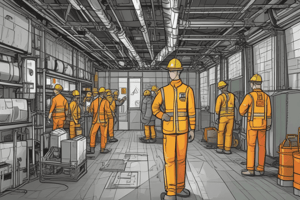Podcast
Questions and Answers
What was the main distraction that caused the workboat's master to lose track of time?
What was the main distraction that caused the workboat's master to lose track of time?
- Monitoring the crew's training
- Completion of paperwork (correct)
- Navigation through the wind farm
- Communication with shore management
Why was the autopilot not utilized while navigating through the wind farm?
Why was the autopilot not utilized while navigating through the wind farm?
- The vessel was moving too fast for autopilot
- It was malfunctioning during the trip
- Company standing orders prohibited its use (correct)
- The crew was not trained to use it
Which role was primarily responsible for the navigational watch while the master was distracted?
Which role was primarily responsible for the navigational watch while the master was distracted?
- The mate, who was completing training (correct)
- The wind farm monitoring staff
- Another workboat in the vicinity
- The crewman, who was busy elsewhere
What should take precedence according to the lessons learned from the incident?
What should take precedence according to the lessons learned from the incident?
What was suggested as a means to reduce the administrative burden during navigation?
What was suggested as a means to reduce the administrative burden during navigation?
Flashcards are hidden until you start studying
Study Notes
IMCA Safety Flash Summary
- IMCA Safety Flashes highlight key safety incidents and lessons to enhance learning and prevent repeat occurrences.
- Members are encouraged to share incident information to improve safety practices and distribution by adding [email protected].
- All shared incident data is anonymized or sanitized to ensure confidentiality.
Incident 1: Diver Hit by Falling Object
- A diver in the diving bell sustained minor injuries from a falling 4.5kg water bottle during a handover between divers.
- The incident occurred when a handle on a water bottle broke while divers were organizing gear, causing the bottle to strike the diver on the head and shoulder.
- The diver received medical attention for minor abrasions and soreness but continued with operations and returned to normal after two days.
Incident 2: Rapid Depth Change During Divers' Transfer
- During subsea operations, a taut wire pulled divers from the seabed to a depth above their maximum excursion limit, posing a risk for pressure injuries.
- Fortunately, both divers reported no adverse effects after the transfer, highlighting the potential risks of rapid depth changes in diving operations.
Incident 3: Chain Hoist Unattended Near Running Engine
- An electric chain hoist was left unattended after lowering spare parts in an engine room, resulting in the chain coiling onto a running main engine.
- A defective push button on the hoist allowed continuous payout even after release, creating a hazardous condition.
- The hoist did not have an emergency stop engaged post-use, and the chain was not stowed according to safety protocols.
- Subsequent inspections revealed that the hoist motor was burnt out and required replacement.
- Recommendations include familiarizing crew with operator manuals, reviewing hoist control functions, increasing maintenance frequencies, and ensuring safe isolation of hoists when not in use.
Incident 4: Workboat Collision with Wind Turbine
- A workboat collided with a wind turbine tower due to the master becoming distracted, leading to a loss of situational awareness while traveling at 5 knots.
- Crew members were engaged in tasks, with no one maintaining a lookout, resulting in the boat slowly turning starboard without autopilot.
- Key lessons emphasize the need for constant vigilance, effective navigation procedures, and minimizing administrative distractions during critical operations.
- Crew should utilize available sensors and data for navigation to identify and prevent potential hazards.
- Improving administrative processes through crew feedback and evaluation can enhance safety without compromising the operational needs.
Studying That Suits You
Use AI to generate personalized quizzes and flashcards to suit your learning preferences.




